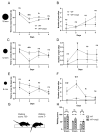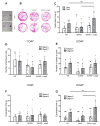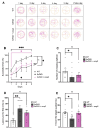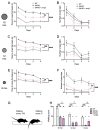N-N-Substituted Piperazine, Cmp2, Improves Cognitive and Motor Functions in 5xFAD Mice
- PMID: 40429735
- PMCID: PMC12111198
- DOI: 10.3390/ijms26104591
N-N-Substituted Piperazine, Cmp2, Improves Cognitive and Motor Functions in 5xFAD Mice
Abstract
The piperazine derivative N-(2,6-difluorophenyl)-2-(4-phenylpiperazin-1-yl)propanamide (cmp2) has emerged as a potential transient receptor potential cation channel, subfamily C, member 6 (TRPC6) modulator, offering a promising pathway for Alzheimer's disease (AD) therapy. Our recent findings identify cmp2 as a novel compound with synaptoprotective effects in primary hippocampal cultures and effective blood-brain barrier (BBB) penetration. In vivo studies demonstrate that cmp2 (10 mg/kg, intraperitoneally) restores synaptic plasticity deficits in 5xFAD mice. This study further shows cmp2's selectivity towards tetrameric TRPC6 channel in silico. Acute administration of cmp2 is non-toxic, with no indications of chronic toxicity, and Ames testing confirms its lack of mutagenicity. Behavioral assays reveal that cmp2 improves cognitive functions in 5xFAD mice, including increased novel object recognition, better passing of the Morris water maze, and improved fear memory, as well as upregulation of motor function in beam walking tests. These findings suggest that cmp2 holds promise as a candidate for AD treatment.
Keywords: Alzheimer’s disease; TRPC6 channel; behavior; piperazine.
Conflict of interest statement
The authors declare no conflicts of interest.
Figures













Similar articles
-
Discovery of a novel piperazine derivative, cmp2: a selective TRPC6 activator suitable for treatment of synaptic deficiency in Alzheimer's disease hippocampal neurons.Sci Rep. 2024 Oct 9;14(1):23512. doi: 10.1038/s41598-024-73849-z. Sci Rep. 2024. PMID: 39384900 Free PMC article.
-
New Positive TRPC6 Modulator Penetrates Blood-Brain Barrier, Eliminates Synaptic Deficiency and Restores Memory Deficit in 5xFAD Mice.Int J Mol Sci. 2022 Nov 4;23(21):13552. doi: 10.3390/ijms232113552. Int J Mol Sci. 2022. PMID: 36362339 Free PMC article.
-
The flavonoid baicalein rescues synaptic plasticity and memory deficits in a mouse model of Alzheimer's disease.Behav Brain Res. 2016 Sep 15;311:309-321. doi: 10.1016/j.bbr.2016.05.052. Epub 2016 May 24. Behav Brain Res. 2016. PMID: 27233830
-
Memory-enhancing and brain protein expression-stimulating effects of novel calcium antagonist in Alzheimer's disease transgenic female mice.Pharmacol Res. 2016 Nov;113(Pt B):781-787. doi: 10.1016/j.phrs.2016.06.020. Epub 2016 Jun 21. Pharmacol Res. 2016. PMID: 27345857 Free PMC article.
-
Chronic kidney disease accelerates cognitive impairment in a mouse model of Alzheimer's disease, through angiotensin II.Exp Gerontol. 2017 Jan;87(Pt A):108-112. doi: 10.1016/j.exger.2016.11.012. Epub 2016 Dec 1. Exp Gerontol. 2017. PMID: 27916702
References
MeSH terms
Substances
Grants and funding
LinkOut - more resources
Full Text Sources
Medical
Molecular Biology Databases

